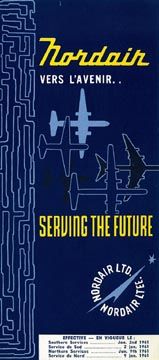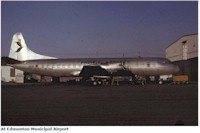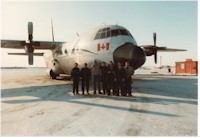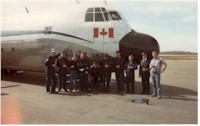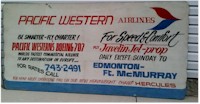|
Timetable effective January 1961. (from Bjorn Larsson collection) |
|
|
PWA also had a "Silver Bullet" in their fleet.
The equipment was used to support the Arctic oil exploration projects. It was unique in that fuel tankers were rare and this aircraft had the name and logo painted over the shiny unpainted aircraft. (Source pwareunion.com) |
|
|
The last commercial operation of the Hercules Division at Pacific Western Airlines reported by Stu Russell.
The crew left to right: F/O Jim Semeniuk, Captain Roy Reaville, Project Manager, Stu Russell, S/O Bill Webster, Maintenance Crew Chief Brent Kirkpatrick, Engineer Robin Bergdahl and Line Maintenance Ron Howe.
|
|
|
(Source pwareunion.com) |
|
|
May 24, 2017 - The Sign from YMM
(Source: pwareunion.com) |
|
|
May 19, 2017 - From Andrew Lindner - Australia A collection of mid-1950's pictures of the Norseman (left) and the Grumman Goose* (right) taken in the Tahsis area. Sent by Andrew Lindner from Australia (relative of passenger). Attribution of photo(s) to Brigitte Thurandt, who sent them to her brother, Hans Lindner. |
|
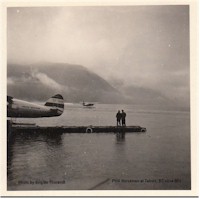 |
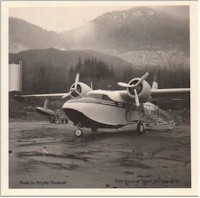 |
|
*Note: Ken Pickford, who generously volunteers his time to proof read the NetLetter, points out that the photo on the right is actually a Grumman Mallard, not a Goose. The Mallard is larger than the Goose, has more windows and a different nose profile and cockpit windows. A major Mallard difference is the tricycle landing gear when operated on land. The Mallard has a nose gear while the Goose is a tail-dragger with a tail wheel. Below are links to photos of the Mallard and Goose, from Airliners.net, to illustrate the differences. The Mallard may even be the one in the photo from Andrew Lindner. (Also note the Canadian Pacific Air Lines Bristol Britannia visible behind the Mallard in the 1958 photo at Vancouver. It would have been very new then as CPAL's first Britannias were delivered sometime in mid-1958). Mallard (fairly rare, only 59 built 1946-1951) More on the Mallard and Goose can be found at Wikipedia: Thanks to Andrew Linder for contributing the photos and to Ken the additional info. |
|

